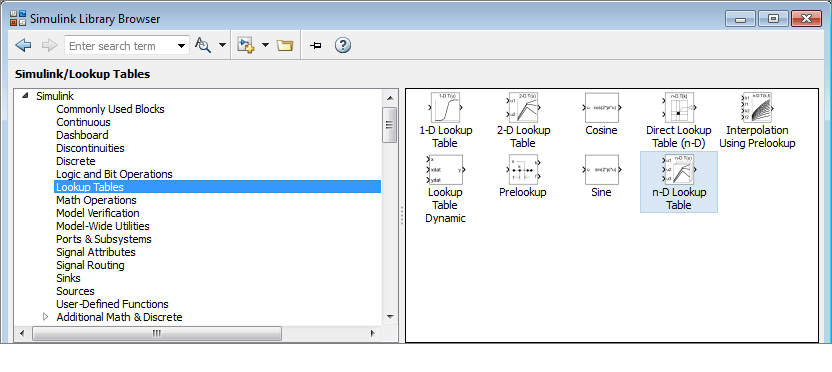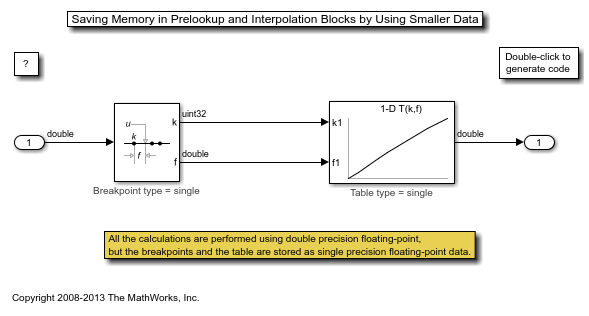非线性
非线性建模利用查找表,通过将输入值映射到输出值求出近似的数学函数
如果您刚开始学习非线性建模,请从使用查找表模块开始。查找表模块使用数据数组将输入值映射到输出值,求出近似的数学函数。要求出 N 个变量的近似函数,请使用 n-D Lookup Table 模块:
要管理您环境中的查找表,请考虑使用查找表编辑器。观看如何使用查找表编辑器(5 分 9 秒)。

模块
| 1-D Lookup Table | 逼近一维函数 |
| 2-D Lookup Table | 逼近二维函数 |
| Direct Lookup Table (n-D) | 为 N 维表进行索引,以检索元素、向量或二维矩阵 |
| Interpolation Using Prelookup | 使用预先计算的索引和区间比值快速逼近 N 维函数。 |
| Lookup Table Dynamic | 使用动态表逼近一维函数 |
| n-D Lookup Table | 逼近 N 维函数 |
| Prelookup | 计算 Interpolation Using Prelookup 模块的索引和区间比 |
| Sine, Cosine | 通过利用象限波对称性的查找表方法实现定点正弦或余弦波 |
类
Simulink.LookupTable | 存储和共享查找表和断点数据,为 ASAP2 和 AUTOSAR 代码生成配置数据 |
Simulink.Breakpoint | Store and share data for a breakpoint set, configure the data for ASAP2 and AUTOSAR code generation |
Simulink.lookuptable.Evenspacing | Configure even spacing set data for lookup table object |
Simulink.lookuptable.Table | Configure table data for lookup table object |
Simulink.lookuptable.Breakpoint | Configure breakpoint set data for lookup table object |
Simulink.lookuptable.StructTypeInfo | Configure settings for structure type that lookup table object uses in the generated code |
工具
| 查找表编辑器 | Create, edit, and manage lookup tables in models (自 R2022a 起) |
主题
使用查找表
- Edit Lookup Table Data with Lookup Table Spreadsheet
Work with lookup table objects with a lookup table spreadsheet. - 输入断点和表数据
为查找表模块指定断点向量和表数据。 - 从 MATLAB 中导入查找表数据
您可以通过在对话框的表和断点选项卡上引用 MATLAB 工作区中变量的表和断点数据,以导入这些数据。下面的示例说明如何从 MATLAB 工作区中导入标准格式与非标准格式的数据,以及如何将数据导出到工作区中。 - 使用 readtable 从 Excel 中导入查找表数据
使用readtable函数将数据导入一个查找表。 - Visualize Lookup Tables Visualized Through Lookup Table Control
Work with custom lookup tables from the Lookup Table Control. - Register Custom Lookup Table Blocks
You can use the Lookup Table Editor to register custom lookup table blocks that you have created. - Create a Logarithm Lookup Table
Work with lookup table blocks. - Optimize Generated Code for Lookup Table Blocks
Optimize code for lookup table blocks. - Row-Major Algorithm in Existing Models Containing Lookup Table Blocks
Update existing models to use row-major layout.
关于查找表
- 关于查找表模块
查找表模块使用数据数组将输入值映射到输出值,来对数学函数进行逼近。 - 查找表剖析
断点和表数据是查找表的组成部分。 - Breakpoint and Table Size Features in Lookup Tables
Simulink® lookup tables have multiple breakpoint and table size features. - 关于选择查找表的规范
为您的应用选择最佳查找表。 - Prelookup and Interpolation Blocks
Use Prelookup and Interpolation Using Prelookup blocks together. - 查找表数据的特征
符合查找表数据要求,并表示不连续数据。 - 逼近函数值的方法
设置查找表模块逼近函数值的方法。
更新以前版本的查找表
- Update Lookup Table Blocks to New Versions
Update existing models to use current versions of lookup table blocks.

